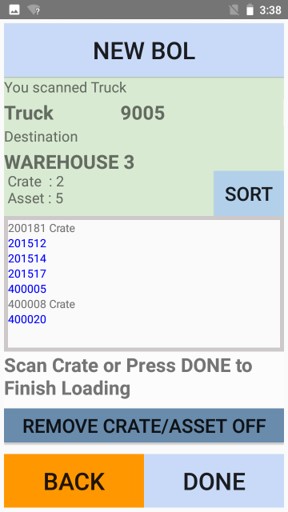The BOL - Bill of Lading
How to produce an accurate BOL Easily and Quickly
SageData is based in Ottawa, Ontario, Canada
The Bill of Lading can be one of the most important documents in the system. It tracks everything that leaves the premises, capturing what left, when it left, who took it, and who loaded it. And it can be an essential tool to manage the transfer or responsibility, from the warehouse to the carrier.
The first requirement is that the BOL be accurate. But it can create a bottleneck, so the next question is, how to produce a BOL quickly? And if staff turnover is high, training must be minimised, so the process should be easily explained.
The fundamentals of the Bill of Lading (BOL) are very simple. Data can be captured with a handheld device. The user logs on, and identifies the carrier, and perhaps the specific truck. Items are identified as they are loaded, by SKU and Qty, by UIC (Unique Identification Code), or pallet ID, usually in barcode format. The driver can be identified, by name and signature, and a record is maintained.
When the transfer is between two locations for a single entity, the BOL can be used at the destination, to make sure that all items are accounted for. Again, a signature can be captured.

So the process is simple. On the surface. What differentiates one system from another, is the
ability to operate effectively in a real world environment. How to handle partial loads, which are to be
completed later. How to handle errors. How to switch between trucks if required, and know which BOL is
active. Putting together a system for a sunny day
, when things go right, is relatively simple.
Designing the system for the real world, for the rainy day
, when things go wrong and users of the
system make mistakes, that is a bit more difficult, but it is where the true value of the systems shows
up. This system detects many potential errors, and assists the user in their resolution.
Emphasis is also placed on simplicity - complexity beneath the surface supports the simplicity of the user interface. This in turn reduces training times, and reduces the opportunity for error. Part of this simplicity comes from a review of each application, so that functions that are not relevant are hidden, and functions that are most frequently used are promoted and simplified.
With this system training times are reduced, human error is minimized, and the system ensures that data is securely captured and protected. Data can be transmitted and immediately viewed remotely, including electronic signatures. The record provides proof of responsibility in the event of loss or damage.
Contact us if the Bill of Lading might help your business needs.
If you found this useful, you might also want to review:
- an introduction to applications
- an introduction to asset management
- an introduction to WMS - warehouse management
systems
- an introduction
to barcode technologies
QAOK5355
